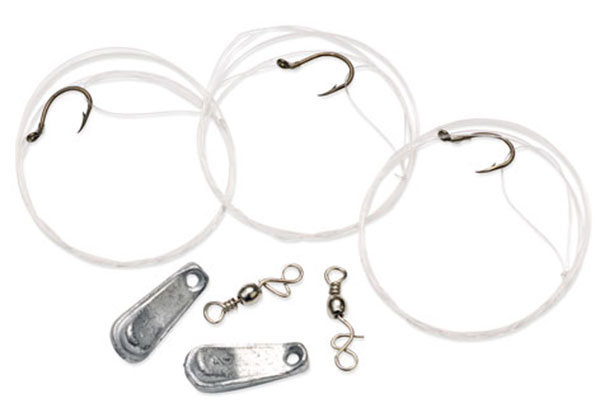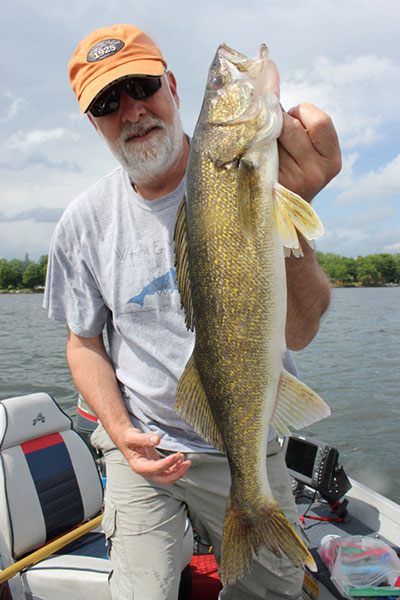By Nathan Shore
(Provided by PRADCO Fishing)
 Livebait RigFrom late summer though fall, live-bait rigging catches walleyes every day, especially when that weight sliding on your main line is perfectly in tune with depth, wind, bait type and size.
Livebait RigFrom late summer though fall, live-bait rigging catches walleyes every day, especially when that weight sliding on your main line is perfectly in tune with depth, wind, bait type and size.
A live bait rig featuring a walking-type sinker resists bottom snags and keeps your livebait in the strike zone.
A leader separates struggling live bait from that weight, giving it room to swim, squirm and attract fish. Simple. Beautiful. Deadly.
But the key is putting that minnow, leech or crawler on a target below the boat. Rigging experts know how to triangulate their targets and allow for current, velocity and depth.
Triangulating, in this case, is simple. As you move deeper, use a larger weight. As the wind picks up, go with a larger weight. And as the size of the bait increases well, you get the idea.
There is no doubt that its a proven system, and the most efficient live-bait delivery system possible, says legendary walleye pro Ted Takasaki. Success is really about location, followed by time of year and bait selection. The key to success is placing live bait precisely on a small target below the boat, and to do that its better to use a weight that is too heavy than one thats too light.
Leaders testing 4- to 8-pounds and 4 feet long (from swivel to hook) are optimum most of the time. Takasaki primarily rigs with two types of sinker from late summer on: Lindy Walking Sinkers and Lindy Rattlin No-Snagg Sinkers.
Lindy rigs really shine on main-lake points and humps from late summer through fall, he said. They maintain bottom contact to cover those critical transitions from hard to soft bottom that attract baitfish. Transitions are classic rigging zones.
Transitions show up on sonar - the hard bottom showing bright and dense while soft substrates return a weaker signal. But Takasaki likes to feel those transitions, too.
I use a sensitive, medium-light 7-foot rod with braided line on the reel, he said. Braid doesnt stretch, so it transmits vibration and feel much better. I can tell when my bait is almost to that point where the bottom changes, helping me visualize exactly where it is.
Fall is a great time to use live bait to take advantage of heavily feeding walleyes.
Im following them down through fall with heavier sinkers, Takasaki said. If its windy, I go even heavier. Again its better to go too heavy than too light. If you cant feel bottom, go up a notch in weight.
Weekend anglers often forget that rigging is not just dragging baits around on bottom. Takasaki likes to criss-cross transitions, moving from shallow to deep and back again.
When I mark walleyes on the edge of a break at 25 feet, I snake from 27 to 23 and back down, he said. When the bait is moving away from them, going shallower or deeper, they react as if its trying to get away. I also lift the rig off bottom as it approaches a marked fish. If Im using the Rattlin No Snagg Sinker, Ill shake it. Raising it off bottom can trigger a reluctant fish. Its that escape trigger - making walleyes think the baitfish is moving away.
Takasaki said anglers should try to remember esactly what they were doing before the bite occurred.
What direction you were going, how fast you were moving, how high or fast you lifted the bait, he explains. All those factors become pattern identification. Once you catch a few fish off a point or hump, try to find the same kind of spots. Thats how you create patterns with Lindy rigs in the fall.
When a fish bites, Takasaki feeds it line for at least 10 seconds while slowly maneuvering the boat toward the fish.
If they really whack it, its 10 seconds, he explained. If they barely pick it up, I let them take it longer. I point the rod right at the fish and move the boat over it, slowly picking up slack. When I feel tension, I set. If I miss, I let them take it longer next time.
Takasaki says that sinker selection is the key element that many anglers overlook for late-summer, early fall walleye rigging.
Its all about striking a balance between wind, depth, and bait size, Takasaki said. You want to stay relatively vertical in deep water. I mostly use ½- to 1-ounce weights late summer through fall because walleyes are 25 to 45 feet down. I also use bigger minnows in fall, lip-hooked on size #4 to size #1 octopus-style hooks. You want to be right below the boat when youre on fish, but you have to keep moving to find them, so you have to strike a balance that way, too. Once you start marking fish, zero in on that depth.
Takasaki likes to pulse his trolling motor, changing direction and speed.
Thats what triggers strikes when Lindy rigging, he said. If Im using that Rattlin No Snagg sinker, I lift, drop and shake it a lot to activate those rattles. That triggers strikes, too. But choose the shape and type of sinker based on bottom type, cover and conditions to be efficient. The classic Lindy Walking Sinker is best suited for sand, gravel and subtle transitions in clear water. The No Snagg shines around broken rock, wood and boulders, and the Rattlin No Snagg is right whenever the water is cloudy.
Another bonus is that No Snagg wobbles a little bit, which moves the bait, he added. It twitches a leech, crawler, or minnow. Thats all it can take to trigger a walleye.



 During late summer, walleyes move out on main-lake points and humps to depths of 20 to 25 feet. By late autumn, its common to find them 35 to 45 feet down.
During late summer, walleyes move out on main-lake points and humps to depths of 20 to 25 feet. By late autumn, its common to find them 35 to 45 feet down.